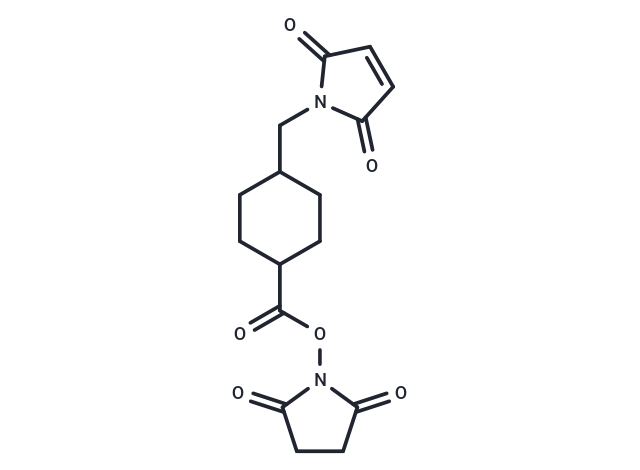Shopping Cart
- Remove All
 Your shopping cart is currently empty
Your shopping cart is currently empty
SMCC (N-Succinimidyl 4-(N-maleimidomethyl)cycl) is a heterobifunctional protein crosslinker.

| Pack Size | Price | Availability | Quantity |
|---|---|---|---|
| 50 mg | $30 | In Stock | |
| 100 mg | $45 | In Stock | |
| 500 mg | $85 | In Stock | |
| 1 g | $125 | In Stock |
| Description | SMCC (N-Succinimidyl 4-(N-maleimidomethyl)cycl) is a heterobifunctional protein crosslinker. |
| In vitro | N-Succinimidyl 4-(N-maleimidomethyl)cycl(SMCC) is an amine-to-sulfhydryl crosslinker that contains NHS-ester and maleimide reactive groups at opposite ends of a medium-length cyclohexane-stabilized spacer arm (8.3 angstroms). SMCC conjugation occurs via a maleimide group that is sulfhydryl (thiol; -SH) reactive and a NHS ester group that is amine reactive and forms stable, covalent protein crosslinks. |
| Cell Research | Branched PEI (25 kDa) was dissolved in PBS buffer to yield a concentration of 1 mg/mL. No-weigh Sulfo-SMCC was dissolved in Milli-Q water with a concentration of 10 mg/mL, then a certain of the prepared no-weigh SulfoSMCC solution was added into 2 mL PEI solution to incubate for 30 min at 37 C. After the PEI-SMCC polymer was formed, TAT solution was added into the polymer at the given molar ratio and incubated for 2 h at 4 C. The concentration of unreacted SMCC and unreacted TAT were removed using Zeba Spin Desalting Columns. The polymer PEI-SMCC-TAT was also characterized and analyzed through FTIR to check if each element was added to the PEI backbone. |
| Synonyms | N-Succinimidyl 4-(N-maleimidomethyl)cycl |
| Molecular Weight | 334.32 |
| Formula | C16H18N2O6 |
| Cas No. | 64987-85-5 |
| Smiles | O=C(ON1C(=O)CCC1=O)C1CCC(CN2C(=O)C=CC2=O)CC1 |
| Relative Density. | 1.42 g/cm3 |
| Storage | store at low temperature,keep away from direct sunlight,store under nitrogen | Powder: -20°C for 3 years | In solvent: -80°C for 1 year | Shipping with blue ice/Shipping at ambient temperature. | ||||||||||||||||||||||||||||||
| Solubility Information | DMSO: 25 mg/mL (74.78 mM), Sonication is recommended. | ||||||||||||||||||||||||||||||
Solution Preparation Table | |||||||||||||||||||||||||||||||
DMSO
| |||||||||||||||||||||||||||||||

Copyright © 2015-2025 TargetMol Chemicals Inc. All Rights Reserved.